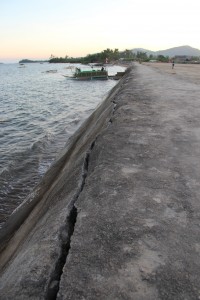 “Kung wala po iyong sea wall na ginawa sa ilallim ng Kalahi-CIDSS, madami na po ang patay dito dahil sa ‘Yolanda’ (If we did not have the seawall Kalahi-CIDSS, a lot of the residents would have died because of ‘Yolanda’).”
“Kung wala po iyong sea wall na ginawa sa ilallim ng Kalahi-CIDSS, madami na po ang patay dito dahil sa ‘Yolanda’ (If we did not have the seawall Kalahi-CIDSS, a lot of the residents would have died because of ‘Yolanda’).”
These were the words by Rogelio Labsan, the former Barangay Captain of Brgy. Mangorocoro in Ajuy, Iloilo. His tone was bas fearful as it was proud as he went on to describe how Kapit-Bisig Laban sa Kahirapan-Comprehensive and Integrated Delivery of Social Services (Kalahi-CIDSS), one of the three main poverty alleviation programs of the Department of Social Welfare and Development (DSWD), was able to protect their community from the savagery of Typhoon Yolanda.
Impact in Ajuy
Ajuy was one of the municipalities in Iloilo that was hit hard by the super typhoon, affecting 11,510 households, 7,064 of which totally lost their homes because of the disaster.
As a coastal community, Brgy. Mangorocoro was no stranger to being affected by the elements.
Prior to the construction of the sea wall, current Barangay Captain Conrado Fernandez said that it was normal for the elementary school campus, where a Kalahi-CIDSS school building now stands, to be flooded during high tide, even on normal weather.
It was the constant fear of being flooded that pushed the residents of Brgy. Mangorocoro to raise for the construction of the sea wall during a KALAHI-CIDSS assembly.
They were able to complete the construction of the sea wall in 2010. When presented with another opportunity by Kalahi-CIDSS, they upgraded their sea wall, having it cemented to make it even more durable to better protect them from harm.
It was this foresight that protected them from experiencing the full impact of “Yolanda”.
While some flooding occurred in Brgy. Mangorocoro at the height of the typhoon, their village did not suffer from any casualties because the sea wall protected them from the rising waters.
Simon Hagurin, one of the senior citizens in Brgy. Mangorocoro who served as a volunteer in Kalahi-CIDSS, shared that he did not want to think about what would have happened to their village had the sea wall not been constructed.
This was echoed by Ajuy Mayor Juancho Alvarez, who said, “Kung wala ang ‘Kalahi’ sea wall, washed out na ang Brgy. Mangorocoro (If the sea wall had not been there, Brgy. Mangoroco would have been washed out).”
The thin crack on the sea wall serves as a silent testament of the ferocity of the typhoon.
Community strength
While the residents of Brgy. Mangorocoro are thankful for the construction of the sea wall, what they are more grateful for is how Kalahi-CIDSS has ingrained in them the spirit of participation and cooperation within their village.
As a project that uses the Community-Driven Development (CDD) strategy, Kalahi-CIDSS seeks to develop the skills and capacities of the citizens, even as it strives to teach them to work together in partnership with their local government units (LGUs) to improve their lives.
By empowering them, Kalahi-CIDSS enables them to become active agents in local development. In effect, the project builds up communities so citizens will be able to work together to lift themselves from poverty.
It is this sense of communal support that the residents of Brgy. Mangorocoro keenly felt.
As Sister Alona Marie Abunda, a local pastor who also served as Kalahi-CIDSS volunteer, shared, “Sa Kalahi-CIDSS, dumami ang friends. At dahil dumami ang friends, tumaas ang cooperation (In Kalahi-CIDSS, we gained more friends. And since we now have more friends, we cooperated more).”
This was completely different from their situation before Kalahi-CIDSS entered the community, when the residents did not really work together, according to Sis. Alona.
When Kalahi-CIDSS started, the Project staff had a hard time gathering the residents together.
According to Teacher Cherry Santiago, it was difficult to conduct barangay assemblies at first.
She said, “Bago ang Kalahi-CIDSS, ang hirap mag-barangay assembly. Kailangan mo pang ipatawag isa-isa ang mga tao, tapos kakaunti pa ang nag-a-attend (Before Kalahi-CIDSS, it was difficult to conduct barangay assemblies. You had to invite the residents one by one, and even then, only a few would attend).”
Since then, conducting barangay assemblies was no longer a problem.
Teacher Cherry proudly shared that their attendance rate is at least 90%, because the residents have since learned through Kalahi-CIDSS that these gatherings are opportunities for them to discuss their concerns and how to solve these.
More importantly, they now understand that each one of them has a personal stake in helping their barangay develop.
As Mayor Alvarez said, Kalahi-CIDSS opened the eyes of the LGU and the residents to the reality that “development is a shared responsibility.”
Editha Labsan, who was one of the Procurement Team (PT) volunteers of Kalahi-CIDSS, stated strongly that the Project opened their eyes on what their community needs.
She said that she preferred having sub-projects constructed by Kalahi-CIDSS than by contractors.
She stated, “Baka kung contractor sub-standard. Kapag kami, sigurado ang quality (If a contractor did it, their work may be sub-standard. If we did the work, we can be assured of the quality).”
She continued, “May transparency sa Kalahi-CIDSS (Kalahi-CIDSS has transparency),” explaining that every phase of project construction is open to perusal by anyone, including concerned citizens and even third-party groups and individuals.
Editha’s sentiments were echoed by Lolo Simon, who said, “Sa Kalahi-CIDSS sigurado kami (In Kalahi-CIDSS, we have assurance).”
This self-assurance, as described by Lorelyn Biogos, a teacher in Mangorocoro Elementary School, was because the residents themselves have a personal stake should they encounter problems with their Kalahi-CIDSS sub-projects.
She said, “May sense of ownership ang community (The community has a sense of ownership for these).”
Teacher Lorelyn shared that the reason why she served as one of the Kalahi-CIDSS volunteers in the construction of the school building is because she knew she had a role to play in helping her community.
She said, “This is part of my legacy. May parte ako sa proyekto (I have a part in the project).”
She continued, “Generations will benefit from this project,” a strong statement coming from someone who works in a profession that ensures the protection of future generations.
Kalahi-CIDSS did not just mobilize the residents to work together. It also made them more sensitive to the different needs of the citizens. One such example is on gender.
As Teacher Cherry said, “Ang mga babae nag-pa-participate na. Nakakatulong na sila sa komunidad sa pamamagitan ng Proyekto (Women now participate. They are able to help out the community through the Project).”
The participation of Teacher Cherry and Teacher Lorelyn, as well as that of the others who helped in the implementation of the school building, also played a role in helping protect residents from “Yolanda”, as the structure was used as one of the evacuation centers following the storm.
Teacher Lorelyn is responsible for managing the bank account that will be used for the operations and maintenance of the school building.
“Medyo nabasa (It got a little wet)”, she said, smiling sheepishly as she presented the passbook, explaining how the status of the booklet, which got slightly damaged because of the torrential rains brought by “Yolanda”.
She said that some funds in the account were taken out for minor repairs to the school following the storm.
Continuing partnership between Ajuy and Kalahi-CIDSS
Ajuy, Iloilo is no stranger to Kalahi-CIDSS. The municipality has been implementing this since 2004, almost from the time of the Project’s inception in 2003.
The implementation of Kalahi-CIDSS has earned Ajuy several recognitions, including a DSWD award for being a model LGU in practicing participation, transparency, and accountability for two straight years in 2011 and 2012.
Mayor Alvarez said that the main reason why Kalahi-CIDSS was successful in Ajuy was because it was able to capacitate and empower the people to actively participate in local decision-making processes.
He said, “The people are given the capacity and power to decide instead of maghintay lang (simply waiting).”
He described how Kalahi-CIDSS has taught the residents that their involvement is important, saying, “It influenced their way of life. The people became assertive because they know what is best for themselves more than anyone else does.”
Mayor Alvarez concluded, “Kalahi-CIDSS taught them to dream again.”
From being a fourth-class municipality in 2001, it has since been re-classified as a second-class municipality in 2009, the change of which is Mayor Alvarez attributes partly due to the interventions introduced by Kalahi-CIDSS.
Since the start of the partnership between Kalahi-CIDSS and Ajuy, 115 community sub-projects were constructed in the municipality, all of which address needs for basic services. These small-scale infrastructures include school buildings, day care centers, health stations, and water systems.
When asked if Ajuy can stand even when Kalahi-CIDSS pulls out of the municipality, the residents were one in saying that they can, because they have already embraced the CDD strategy and will work doubly hard to ensure that they will continue following the processes instituted by the Project.
According to them, disasters will not keep them from working together as a community. On the contrary, CDD helped them respond to the problems better, because they were able to help each other in the recovery operations in the aftermath of “Yolanda”.
One volunteer sums up appreciation with CDD, saying, “Na-in love na kami sa Kalahi-CIDSS (We fell in love with Kalahi-CIDSS).” ###


